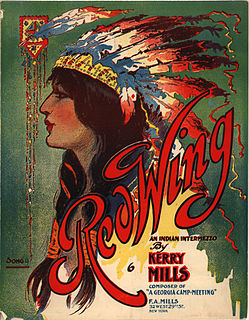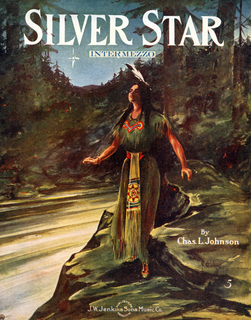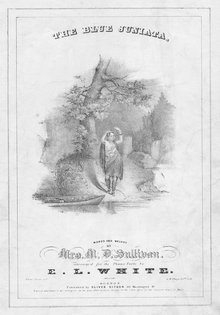
Stephen Collins Foster, known also as "the father of American music", was an American composer and songwriter known primarily for his parlour and minstrel music during the Romantic period. He wrote more than 200 songs, including "Oh! Susanna", "Hard Times Come Again No More", "Camptown Races", "Old Folks at Home", "My Old Kentucky Home", "Jeanie with the Light Brown Hair", "Old Black Joe", and "Beautiful Dreamer", and many of his compositions remain popular today. He has been identified as "the most famous songwriter of the nineteenth century" and may be the most recognizable American composer in other countries. Most of his handwritten music manuscripts are lost, but editions issued by publishers of his day feature in various collections.

The Kittanning Path was a major east-west Native American trail that crossed the Allegheny Mountains barrier ridge connecting the Susquehanna River valleys in the center of Pennsylvania to the highlands of the Appalachian Plateau and thence to the western lands beyond drained by the Ohio River. Kittanning Village was the first major Delaware (Lenape) Indian settlement along the descent from the Allegheny Plateau.

Egbert Anson Van Alstyne was an American songwriter and pianist. Van Alstyne was the composer of a number of popular and ragtime tunes of the early 20th century. He was Jewish.

Paul Dresser was an American singer, songwriter, and comedic actor of the late nineteenth and early twentieth centuries. Dresser performed in traveling minstrel and medicine-wagon shows and as a vaudeville entertainer for decades, before transitioning into a music publishing in the later years of his life. His biggest hit, "On the Banks of the Wabash, Far Away" (1897), was the best selling song of its time. Although Dresser had no formal training in music composition, he wrote ballads that had wide appeal, including some of the most popular songs of the era. During a career that spanned nearly two decades, from 1886 to 1906, Dresser composed and published more than 150 songs. Following the success of "Wabash", many newspapers compared Dresser to popular composer Stephen Foster. "On the Banks of the Wabash, Far Away" became the official song of Indiana in 1913. The Paul Dresser Birthplace in Terre Haute is designated as a state shrine and memorial. Dresser was inducted into the Songwriters Hall of Fame in 1970.
Starlight is the visible radiation emitted by stars other than the Sun.

"On the Banks of the Wabash, Far Away" was among the best-selling songs of the 19th century, earning over $100,000 from sheet-music revenues. Written and composed by American songwriter Paul Dresser, it was published by the Tin Pan Alley firm of Howley, Haviland and Company in October 1897. The lyrics of the ballad reminisce about life near Dresser's childhood home by the Wabash River in Indiana, United States. The song remained popular for decades, and the Indiana General Assembly adopted it as the official state song on March 14, 1913. The song was the basis for a 1923 film of the same title. Its longtime popularity led to the emergence of several lyrical versions, including an 1898 anti-war song and a Swedish version that was a number-one hit.

"Nearer, My God, to Thee" is a 19th-century Christian hymn by Sarah Flower Adams, which retells the story of Jacob's dream. Genesis 28:11–12 can be translated as follows: "So he came to a certain place and stayed there all night, because the sun had set. And he took one of the stones of that place and put it at his head, and he lay down in that place to sleep. Then he dreamed, and behold, a ladder was set up on the earth, and its top reached to heaven; and there the angels of God were ascending and descending on it..."

"Favorite Girl" is a song by Canadian singer Justin Bieber. The song was written and produced by D'Mile, and Antea Birchett, Anesha Birchett, and Delisha Thomas also receive writing credits. Bieber debuted the acoustic version of his song in his official YouTube account after American country pop singer Taylor Swift used Bieber's single "One Time" as background music in one of her video tour diaries. The song was later released exclusively to iTunes as the second promotional single from his debut studio release, My World on November 4, 2009.

Clara Kathleen Barnett Rogers, was an English-born American composer, singer, writer and music educator.

"Red Wing" is a popular song written in 1907 with music by F.A Mills and lyrics by Thurland Chattaway. Mills adapted the music of the verse from Robert Schumann's piano composition "The Happy Farmer, Returning From Work" from his 1848 Album for the Young, Opus 68. The song tells of a young Indian girl's loss of her sweetheart who has died in battle.

"From the Land of the Sky-Blue Water" (1909) is a popular song composed by Charles Wakefield Cadman. He based it on an Omaha love song collected by Alice C. Fletcher. "Sky-blue water" or "clear blue water" is one possible translation of "Mnisota," the name for the Minnesota River in the Dakota language.

"Silver Star" is an intermezzo composed by Charles L. Johnson in 1910. In 1911, William R. Clay added lyrics which tell of an Indian warrior eloping with an unnamed Indian maiden whom he refers to as his "silver star".
Arlene Zallman was an American composer and music educator.
Marion Dix Sullivan (1802–1860) was an American songwriter and composer. She was born in Boscawen, New Hampshire, the daughter of Timothy Dix and Abigail Wilkins and the sister of General John Adams Dix of New York. She married John Whiting Sullivan in 1825 and had one son, John Henry, who died of drowning in 1858.
Priti Paintal is an East Indian composer, performer, music producer and promoter who lives and works in England.
Esther Alejandro de León is a Puerto Rican composer.
Carol Ann Weaver is a composer, pianist, and teacher, and is currently a Canadian citizen.











